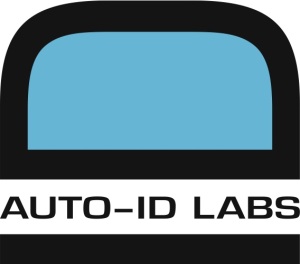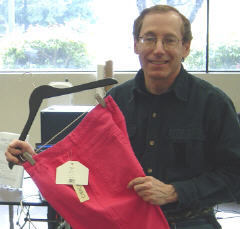
Surveillance is the monitoring of behavior, many activities, or information for the purpose of information gathering, influencing, managing or directing. This can include observation from a distance by means of electronic equipment, such as closed-circuit television (CCTV), or interception of electronically transmitted information like Internet traffic. It can also include simple technical methods, such as human intelligence gathering and postal interception.
Radio-frequency identification (RFID) uses electromagnetic fields to automatically identify and track tags attached to objects. An RFID system consists of a tiny radio transponder, a radio receiver and transmitter. When triggered by an electromagnetic interrogation pulse from a nearby RFID reader device, the tag transmits digital data, usually an identifying inventory number, back to the reader. This number can be used to track inventory goods.

Near-field communication (NFC) is a set of communication protocols that enables communication between two electronic devices over a distance of 4 cm (1.57 in) or less. NFC offers a low-speed connection through a simple setup that can be used to bootstrap more capable wireless connections. Like other "proximity card" technologies, NFC is based on inductive coupling between two antennas present on NFC-enabled devices—for example a smartphone and a printer—communicating in one or both directions, using a frequency of 13.56 MHz in the globally available unlicensed radio frequency ISM band using the ISO/IEC 18000-3 air interface standard at data rates ranging from 106 to 848 kbit/s.

Wheels of Zeus was a company founded in 2002 by Apple co-founder Steve Wozniak. WoZ made wireless hardware for keeping track of the physical location of enabled objects.

The Auto-ID Labs network is a research group in the field of networked radio-frequency identification (RFID) and emerging sensing technologies. The labs consist of seven research universities located on four different continents. These institutions were chosen by the former Auto-ID Center to design the architecture for the Internet of Things together with EPCglobal. The federation was established in 1999; the network they have developed is at the heart of a proposal sponsored by EPCglobal and supported by GS1, GS1 US, Wal-Mart, Hewlett-Packard, and others to use RFID and the Electronic Product Code (EPC) in the identification of items in the supply chain for companies. The areas of expertise range from hardware to software to business research related to RFID.

A microchip implant is an identifying integrated circuit placed under the skin of an animal. The chip, about the size of a large grain of rice, uses passive radio-frequency identification (RFID) technology, and is also known as a PIT tag. Standard pet microchips are typically 11–13 mm long and 2 mm in diameter.
Automatic identification and data capture (AIDC) refers to the methods of automatically identifying objects, collecting data about them, and entering them directly into computer systems, without human involvement. Technologies typically considered as part of AIDC include QR codes, bar codes, radio frequency identification (RFID), biometrics, magnetic stripes, optical character recognition (OCR), smart cards, and voice recognition. AIDC is also commonly referred to as "Automatic Identification", "Auto-ID" and "Automatic Data Capture".
Object hyperlinking is a term that refers to extending the Internet to objects and locations in the real world. Object hyperlinking aims to extend the Internet to the physical world by attaching tags with URLs to tangible objects or locations. These object tags can then be read by a wireless mobile device and information about objects and locations retrieved and displayed.
Liz McIntyre is a consumer privacy expert and founder of CAMCAT - Citizens Against Marking, Chipping and Tracking, an organization that works to prevent forced human tracking technologies like implantable microchips. She and co-author Katherine Albrecht wrote the RFID privacy book Spychips: How Major Corporations and Government Plan to Track your Every Move. At one time, McIntyre was the Communications Director for CASPIAN, an organization that advocated free-market, consumer-based solutions to the problem of retail privacy invasion.

Paul A. Moskowitz works at the IBM Thomas J. Watson Research Center in New York. Moskowitz is a graduate of Stuyvesant High School in New York City, received a Ph.D. in physics at New York University, and has held research and teaching positions at the Université Grenoble, Johannes Gutenberg-Universität Mainz, and at the University of Colorado Boulder. His early work in the area of nuclear physics resulted in the publication of the Moskowitz-Lombardi rule.
A contactless smart card is a contactless credential whose dimensions are credit card size. Its embedded integrated circuits can store data and communicate with a terminal via NFC. Commonplace uses include transit tickets, bank cards and passports.
The clipped tag is a radio frequency identification (RFID) tag designed to enhance consumer privacy. RFID is an identification technology in which information stored in semiconductor chips contained in RFID tags is communicated by means of radio waves to RFID readers. The most simple passive RFID tags do not have batteries or transmitters. They get their energy from the field of the reader. They transfer their information to the reader by modulating the signal that is reflected back to the reader by the tag. Because tags depend on the reader for power their range is limited, typically up to 10 meters (33 ft) for UHF RFID tags.
The ID Sniper rifle is an art project, a fictional, hoax weapon devised by artist Jakob Boeskov and industrial designer Kristian von Bengtson. The rifle supposedly shoots GPS chips, and the police force may tag persons with this rifle for later easy retrieval. It was produced by the fictional company Empire North.

The Beast may refer to one of two beasts described in the Book of Revelation.
Wireless identity theft, also known as contactless identity theft or RFID identity theft, is a form of identity theft described as "the act of compromising an individual’s personal identifying information using wireless mechanics." Numerous articles have been written about wireless identity theft and broadcast television has produced several investigations of this phenomenon. According to Marc Rotenberg of the Electronic Privacy Information Center, wireless identity theft is a serious issue as the contactless (wireless) card design is inherently flawed, increasing the vulnerability to attacks.
Real-time locating systems (RTLS), also known as real-time tracking systems, are used to automatically identify and track the location of objects or people in real time, usually within a building or other contained area. Wireless RTLS tags are attached to objects or worn by people, and in most RTLS, fixed reference points receive wireless signals from tags to determine their location. Examples of real-time locating systems include tracking automobiles through an assembly line, locating pallets of merchandise in a warehouse, or finding medical equipment in a hospital.
A human microchip implant is any electronic device implanted subcutaneously (subdermally) usually via an injection. Examples include an identifying integrated circuit RFID device encased in silicate glass which is implanted in the body of a human being. This type of subdermal implant usually contains a unique ID number that can be linked to information contained in an external database, such as identity document, criminal record, medical history, medications, address book, and other potential uses.

Impinj, Inc. is a manufacturer of radio-frequency identification (RFID) devices and software. The company was founded in 2000 and is headquartered in Seattle, Washington. The company was started based on the research done at the California Institute of Technology by Carver Mead and Chris Diorio. Impinj currently produces EPC Class 1, Gen 2 passive UHF RFID chips, RFID readers, RFID reader chips, and RFID antennas, and software applications for encoding chips, and gathering business intelligence on RFID systems.

EM Microelectronic, based in Marin, La Tène near Neuchâtel in Switzerland, is a developer and semiconductor manufacturer specialized in the design and production of ultra low power, low voltage integrated circuits for battery-operated and field-powered applications in consumer, automotive and industrial areas. EM Microelectronic SA is a subsidiary of The Swatch Group.
Various schools have been using radio-frequency identification technology to record and monitor students.








